- Joined
- Oct 30, 2019
- Messages
- 225
Ok, not quite shopping cart but I imagine this is a lot of the same design and hardware as shopping carts.
My wife bought a couple of food service "speed racks" at auction, for a project she is working on. We made a few modifications to make them narrower (her project doesn't involve standard hotel trays/pans), but also some of the wheels needed repair.
On the first rack we were modifying, the wheels were on swivels. The axles themselves were 3/8" diameter, cross-drilled with a grease zerk on the end of the axle so that the two flange bearings in the wheel could be greased from inside.
The problem is that these had not been greased for a long time, the bearings got rusty, started self-destructing. The flanged bearings started spinning in the hard rubber of the wheel since the bearing wasn't rolling, and eventually the wheels were just sloppily rotating on the remnants of the bearings and the wheels themselves.
I don't have pictures from "before", just this listing picture of one of the racks:
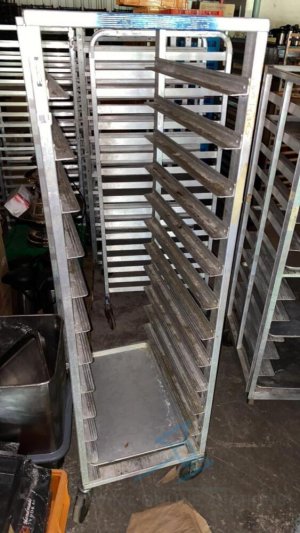
You may be able to see that the foreground-left wheel doesn't look quite right, the ones in the back are worse.
We started by removing the wheels and cutting the rack in half to remove approximately 13/16" of width from it:
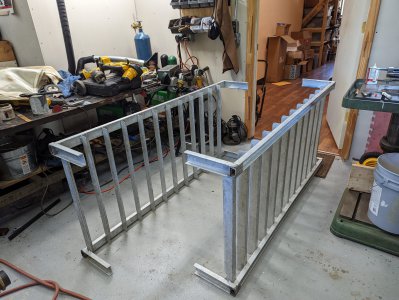
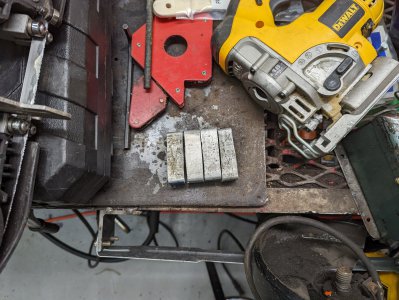
I fully disassembled the wheels, which included a couple broken bolts in the threads where they are retained in the frame of the rack
Here are some of the old bearings. Those which were intact were totally seized, so the wheels were either skidding or spinning on the outer bearing races.
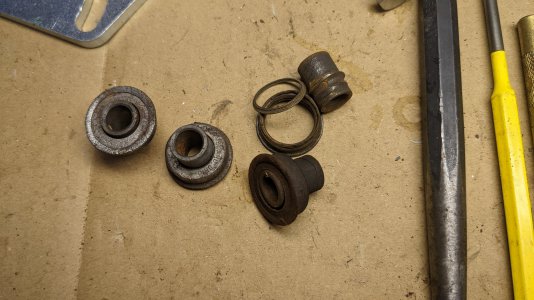
I chucked the wheels up one at a time in the Logan 200, indicated off the middle of the bore which wasn't chewed up
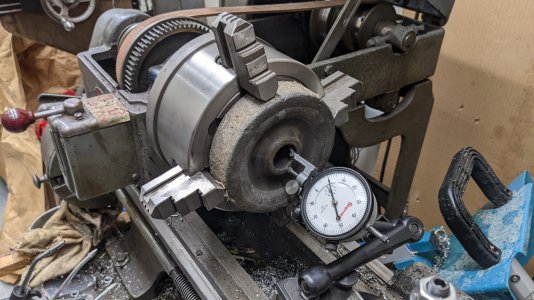
With an indexable boring bar that had triangular inserts and a sharp nose radius (I don't know exactly what it is, it was in a box of hardware I was given or an auction or something), I was getting a decent depth of cut and surface finish. I increased the ID from the original 3/4" to 1-1/8" because:
- the original bearings were now a sloppy fit, they were meant for a 3/4" bore
- Rather than bore it and put in a sleeve with new 3/4" flanged bearings, I found cheaper 1-1/8 OD flange bearings on ebay, apparently some shopping cart wheels use these so they were cheap
The OD of the wheels have worn oddly because of the damage to the bearings, but it's fine for my wife's project and they'll eventually wear normally
I took a cleanup pass on the face of the hub in the middle of the wheels, so that the bearings' outer race flange would definitely be perpendicular to the bore itself. I can always put washers or spacers between the wheel and body of the swivel/mount if this allows too much slop
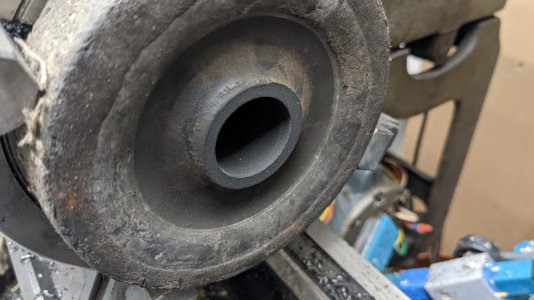
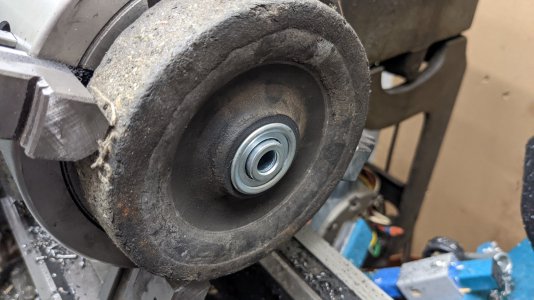
Reassembled and installed, with the frame bolted back together at its new dimension. Rolls and moves just like they're brand new again.
The bearings in the swivels don't feel like they are in the best shape, but I snuck some grease into them and they're tolerable. Those would be more difficult to fix since they are pressed-together and the bearing races are integral to the metal parts themselves. These aren't actually going to be moved more than a few feet a few times/week, so as long as the swivels don't seize up this is fine.
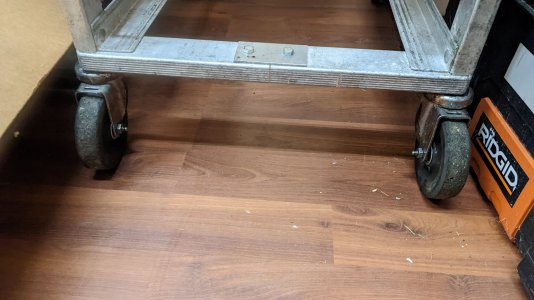
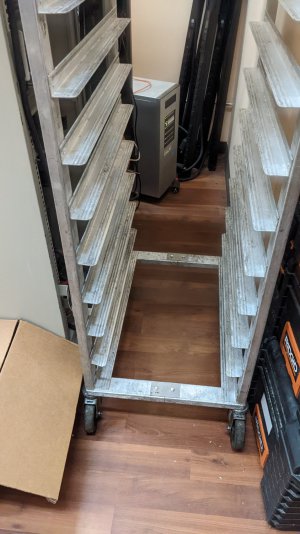
Thanks for reading -- I need to remember to take more pictures earlier in a repair like this, since by the time I realize there might be content-of-interest it's too late!
My wife bought a couple of food service "speed racks" at auction, for a project she is working on. We made a few modifications to make them narrower (her project doesn't involve standard hotel trays/pans), but also some of the wheels needed repair.
On the first rack we were modifying, the wheels were on swivels. The axles themselves were 3/8" diameter, cross-drilled with a grease zerk on the end of the axle so that the two flange bearings in the wheel could be greased from inside.
The problem is that these had not been greased for a long time, the bearings got rusty, started self-destructing. The flanged bearings started spinning in the hard rubber of the wheel since the bearing wasn't rolling, and eventually the wheels were just sloppily rotating on the remnants of the bearings and the wheels themselves.
I don't have pictures from "before", just this listing picture of one of the racks:

You may be able to see that the foreground-left wheel doesn't look quite right, the ones in the back are worse.
We started by removing the wheels and cutting the rack in half to remove approximately 13/16" of width from it:


I fully disassembled the wheels, which included a couple broken bolts in the threads where they are retained in the frame of the rack
Here are some of the old bearings. Those which were intact were totally seized, so the wheels were either skidding or spinning on the outer bearing races.

I chucked the wheels up one at a time in the Logan 200, indicated off the middle of the bore which wasn't chewed up

With an indexable boring bar that had triangular inserts and a sharp nose radius (I don't know exactly what it is, it was in a box of hardware I was given or an auction or something), I was getting a decent depth of cut and surface finish. I increased the ID from the original 3/4" to 1-1/8" because:
- the original bearings were now a sloppy fit, they were meant for a 3/4" bore
- Rather than bore it and put in a sleeve with new 3/4" flanged bearings, I found cheaper 1-1/8 OD flange bearings on ebay, apparently some shopping cart wheels use these so they were cheap
The OD of the wheels have worn oddly because of the damage to the bearings, but it's fine for my wife's project and they'll eventually wear normally
I took a cleanup pass on the face of the hub in the middle of the wheels, so that the bearings' outer race flange would definitely be perpendicular to the bore itself. I can always put washers or spacers between the wheel and body of the swivel/mount if this allows too much slop


Reassembled and installed, with the frame bolted back together at its new dimension. Rolls and moves just like they're brand new again.
The bearings in the swivels don't feel like they are in the best shape, but I snuck some grease into them and they're tolerable. Those would be more difficult to fix since they are pressed-together and the bearing races are integral to the metal parts themselves. These aren't actually going to be moved more than a few feet a few times/week, so as long as the swivels don't seize up this is fine.


Thanks for reading -- I need to remember to take more pictures earlier in a repair like this, since by the time I realize there might be content-of-interest it's too late!

